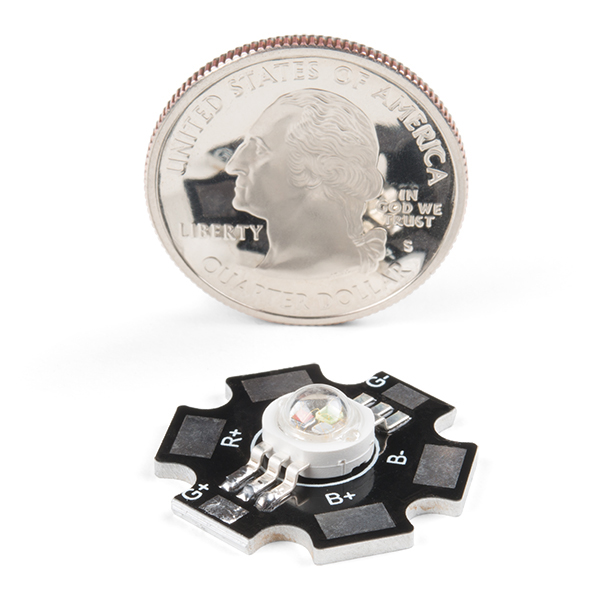So much power and light from such a small package. This 3W per channel, Triple Output High Power RGB LED is sure to shed a lot of light on any project you add it to. This LED acts as any other LED except they require much more power while delivering a light as intense of a thousand suns going super nova (this is an exaggeration but you know what we mean)!
Please be aware that with all three LEDs (9W total output), you will need additional heat sinking.
This LED sits upon an aluminum backed PCB to help with heat dissipation but with a 9W total output, additional heat sinking will be required. Additionally, each LED requires an operating voltage of 2.2-2.6V for red, 3.2-3.8V for green, and 3.2-3.8V for blue.
Note: We like to joke around about super novas and all, but seriously, don't look directly into the LED.
- Size (approx.): 18mm (D) x 8mm (H)
- Aluminum PCB for thermal dissipation
- Operating Voltage:
- Red: 2.2-2.6V
- Green: 3.2-3.8V
- Blue: 3.2-3.8V
- Wavelength:
- Red: 620nm
- Green: 520nm
- Blue: 460nm
- Viewing Angle: 140°
- Datasheet
- Lumen to MCD Calculator
- Related Hookup Guides:
Triple Output High Power RGB LED Product Help and Resources
Touch Potentiometer Hookup Guide
October 22, 2015
Learn how to use the SparkFun Touch Potentiometer to control lighting, volume or other inputs in your daily life.
PicoBuck Hookup Guide v12
February 18, 2016
The PicoBuck board is a high-efficiency three-channel constant-current LED driver.
FemtoBuck Constant Current LED Driver Hookup Guide v13
December 10, 2015
The FemtoBuck board is a high-efficiency, single-channel constant-current LED driver.
Core Skill: Soldering
This skill defines how difficult the soldering is on a particular product. It might be a couple simple solder joints, or require special reflow tools.
Skill Level: Competent - You will encounter surface mount components and basic SMD soldering techniques are required.
See all skill levels
Core Skill: Electrical Prototyping
If it requires power, you need to know how much, what all the pins do, and how to hook it up. You may need to reference datasheets, schematics, and know the ins and outs of electronics.
Skill Level: Competent - You will be required to reference a datasheet or schematic to know how to use a component. Your knowledge of a datasheet will only require basic features like power requirements, pinouts, or communications type. Also, you may need a power supply that?s greater than 12V or more than 1A worth of current.
See all skill levels
Comments
Looking for answers to technical questions?
We welcome your comments and suggestions below. However, if you are looking for solutions to technical questions please see our Technical Assistance page.
Customer Reviews
No reviews yet.



If we use the Picobuck to drive this 3x3 W LED, do we need to modifiy it so each channel can provide about 1 A? Alternatively, can we drive the LED without modifying tje PicoBuck (3x330 mA); will the LED just be less bright?
Hi Sparkfun and others,
The information for this product is incorrect - each LED is 1W, for a combined power of 3W for the whole module. It's not 3W per LED as stated above. I have checked this with the manufacturer and they confirm this.
Is there any diffuser available which fits these star LEDs?
Forward current? Datasheet for previous version of product seems of little help. At 3-watts per channel, I can divide by Vf to get If per channel, but that seems unreliable. At 9-watts per package, a thoughtful datasheet would be useful.
The PCB is actually between 22-23mm, not 18.
If these are SO BRIGHT, why is there no documentation of their light output, either in Lumen or MCD?
This is the previous version of this product. I am not sure how they compare to each other, but datasheet should give you a general idea of how bright it is.
Previous version:
From the manufacturer (outside of the datasheet), it looks like the lumens for each channel is: